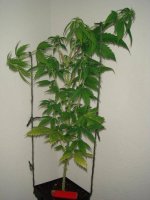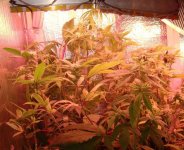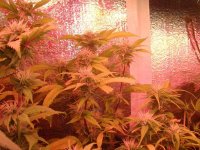SupraSPL
Member
The last lamp did a great job but more efficient emitters are available now so I tore it down and started from scratch. I saved and reused most of the copper tape, the 635nm reds and of course the heatsinks and drivers. The old white and blue emitters ended up being used for the vegging lamp so nothing goes to waste.
The new lamps will be using cool white Golden Dragon LX bin, 635nm Golden Dragon reds and newly available 660nm deep reds. The white string will be run at .7A and the red string will be run at .45A.
For now there are 4 modules with a total dissipation of 157 watts and a total input power of 177 watts (drivers 88.7% efficient at converting 120v AC to constant current DC). The 5th and 6th module are not ready yet.

The room is kept at 80f-85f during lights on and about 60f during lights out. Canopy is kept short by a combination of topping and tying. Fan leaves are gradually removed to expose bud sites to direct light.
The soil is reused organic mix peat/diatomaceous earth/perlite/dolomite lime/Epsoma plant tone. Fertilizing every watering with Blue Mountain Organics liquid ferts (guano/molasses based). The water is R/O remineralized by dissolving dolomite lime from 2ppm to about 110ppm.
At the beginning of the grow the lamps were turned down so I have to keep track of the dissipation and dates I cranked them up in order to calculate the average grams/watt for each girl. Last time a Puna reached 1.5 grams per watt but there were calmag problems and under fert problems so hopefully there is room for improvement. Also the new lamp is using a better spectrum and more efficient whites so I am daring to hope for 2 grams per watt at some point from the indica doms. The most I have ever seen from a 1.5 liter pot was 16 grams. There are 12 girls so each is getting 13w dissipation. So a single plant would have to yield 26g in 8 weeks to reach that goal.
Another bottle neck to the 2 grams/watt goal might be the tiny containers. In order to sample many different girls at once with a short canopy small containers are used (1.5 liters). Since the penetration of the lamps is limited a canopy range 6-18" is being used so maybe the small containers will still be able to get the job done. During the 3rd week stretch some girls need to be watered every day.
More pics coming. This is Mr Nice Spice 34 days veg from bean and 20 days of 11.5/12.5:
The new lamps will be using cool white Golden Dragon LX bin, 635nm Golden Dragon reds and newly available 660nm deep reds. The white string will be run at .7A and the red string will be run at .45A.
For now there are 4 modules with a total dissipation of 157 watts and a total input power of 177 watts (drivers 88.7% efficient at converting 120v AC to constant current DC). The 5th and 6th module are not ready yet.

The room is kept at 80f-85f during lights on and about 60f during lights out. Canopy is kept short by a combination of topping and tying. Fan leaves are gradually removed to expose bud sites to direct light.
The soil is reused organic mix peat/diatomaceous earth/perlite/dolomite lime/Epsoma plant tone. Fertilizing every watering with Blue Mountain Organics liquid ferts (guano/molasses based). The water is R/O remineralized by dissolving dolomite lime from 2ppm to about 110ppm.
At the beginning of the grow the lamps were turned down so I have to keep track of the dissipation and dates I cranked them up in order to calculate the average grams/watt for each girl. Last time a Puna reached 1.5 grams per watt but there were calmag problems and under fert problems so hopefully there is room for improvement. Also the new lamp is using a better spectrum and more efficient whites so I am daring to hope for 2 grams per watt at some point from the indica doms. The most I have ever seen from a 1.5 liter pot was 16 grams. There are 12 girls so each is getting 13w dissipation. So a single plant would have to yield 26g in 8 weeks to reach that goal.
Another bottle neck to the 2 grams/watt goal might be the tiny containers. In order to sample many different girls at once with a short canopy small containers are used (1.5 liters). Since the penetration of the lamps is limited a canopy range 6-18" is being used so maybe the small containers will still be able to get the job done. During the 3rd week stretch some girls need to be watered every day.
More pics coming. This is Mr Nice Spice 34 days veg from bean and 20 days of 11.5/12.5:










